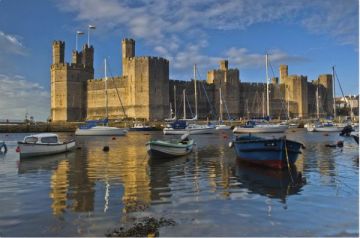Changes to Scottish life from the growth of industry and the Agricultural Revolution made Victorian Scotland a very different place from what it had been in preceding centuries. Most of the population now lived in cities and large towns. Perhaps the greatest change was wrought by the invention of the steam engine.
Steam made possible great changes in industry but it also opened up transportation. The first successful steam rail service was demonstrated by George Stephenson in 1831 and it was not long before rail service was established between all the major urban areas of Scotland. Rail made possible the quick and relatively inexpensive transport of goods, which in turn encouraged trade and the growth of industry. The most important of these industries were shipbuilding, iron, steel, mining, and engineering.
The need for a rail bridge across the Forth led to the creation of one of the greatest engineering works in Victorian Britain; the Forth Rail Bridge. The eye-catching design was the work of Benjamin Baker and Sir John Fowler. It took fully 7 years to build the bridge, which opened on 4 March 1890.
Though Scotland's industries were undoubtedly successful in the Victorian period, this success came at a social cost. Many of the workers who kept the factories going lived in extremely poor conditions. Most lived in city tenement slums, which were breeding grounds for disease and crime. Abortive attempts by workers to demand better conditions led to government crackdowns; the authorities were afraid of social revolutions like those in several European countries during this period.
Gradual reforms to the law improved social conditions and extended voting rights, but the biggest changes took place when city governments began to clear the slums and provide council housing. Trade unions were formed to fight for better working conditions. The most important of these unions was the United Coal and Iron Miner's Association of Scotland.
People like James Keir Hardie and his Scottish Labour Party lobbied for better working conditions for labourers and proposed sweeping Socialist reforms. The SLP then allied with other labour societies to form the Independent Labour Party. The first secretary of the ILP was Ramsay MacDonald, who would eventually become Britain's first Labour Prime Minister in 1924.
Another major step forward was the 1872 Education Act. This took education out of church hands and established a school system run by locally elected boards. Schools were set up for all children aged 5 to 13.
Scotland became a popular destination for tourists, aided by the popularity of Sir Walter Scott's novels, with their romantic description of Scottish locations. When Scott persuaded George IV to wear tartan on a visit to Scotland, public perception of Scottish tradition and heritage began to change. Things Scottish became fashionable.
This boost to Scotland's image was elevated after Queen Victoria and Prince Albert bought Balmoral Castle, in the southern Highlands. Scottish dress became very popular. Unfortunately, the Victorians weren't content with traditional Scottish dress and customs; they rather invented a new Scottish set of tartan clothing and style, which has become the style we associate with Scotland today. Many English purchased Scottish houses, established estates, and came to Scotland regularly to fish, hunt, and shoot. Many Scots were employed as ghillies, gamekeepers, and foresters on these new estates.
Many other Scots lived on small farms, usually in coastal locations. These farms, or crofts, were simple cottages with room for people at one end and animals at the other. Crofters lived very simply, making a meagre living from small plots of land, grazing animals on common fields. But crofters had few rights; landowners could raise rents arbitrarily, and crofters could be evicted if the landowner chose.
Some people tried to fight for the rights of crofters. John Murdoch of Inverness began the Highlander newspaper, speaking out for the rights of crofters. Incidents on Skye and Lewis where crofters were prosecuted for protesting against evictions helped bring the weight of public opinion to bear on the issue and many of the worst excesses of landowners were curbed. The Crofter's Commission was established to ensure fair treatment of crofters, though many continued to emigrate overseas.
Emigration was an ongoing issue throughout the Victorian period. Living conditions in the Highlands, in particular, were so poor, and prospects so bleak, that many Scots simply chose to begin life fresh in a new land. Many left for Canada, Australia, and New Zealand. As a result, large expanses of the Highlands were simply deserted.
